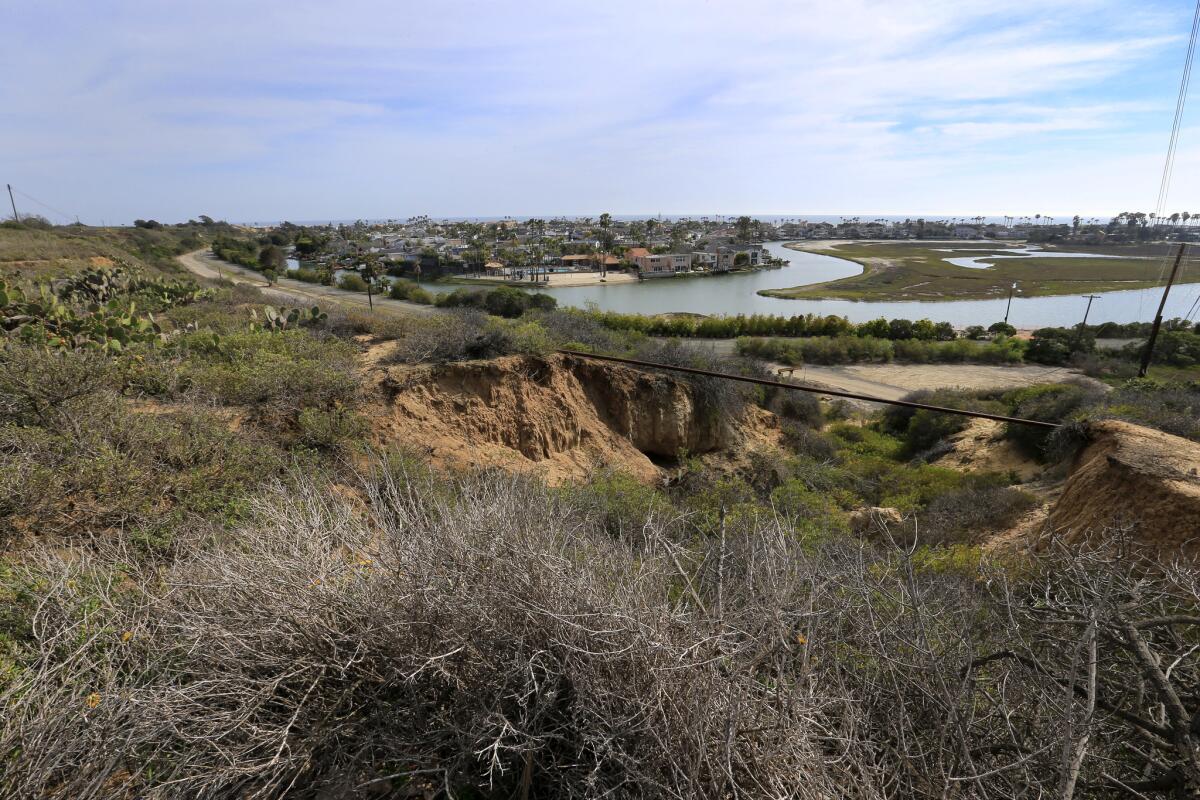Banning Ranch developer allowed environmental degradation to site

The developers who want to build hundreds of homes and a resort hotel on a coastal oil field in Orange County have dressed their project in green, saying they will clean up a fenced-off brownfield and create a nature preserve open to the public.
The Newport Banning Ranch website calls the project partners “the beyond green team” and promises they will restore land blighted by seven decades of oil production.
“We’ll soon be re-acquainted with nature and the creatures that used to call this place home,” the website says. “We’re looking forward to seeing you again, burrowing owls, fairy shrimp and California gnatcatchers.”
See more of our top stories on Facebook >>
There is no mention that one of the green team partners, the oil company Aera Energy, has co-owned the property — the largest private, undeveloped coastal parcel in Southern California — for nearly two decades, during which time it has been named in several environmental orders involving the destruction of wetlands and wildlife habitat on the 401-acre tract.
We’ll soon be re-acquainted with nature and the creatures that used to call this place home.
— Statement on Newport Banning Ranch website
“They’re making a very big deal of the fact that, ‘Gosh, this land is really terrible,’ ” said biologist Robb Hamilton, a consultant for project opponents. “They’re the ones responsible for the condition of their land.”
In 1998, Aera and two other companies were the subject of a U.S. Environmental Protection Agency administrative order demanding an end to the dumping of concrete rubble and dirt on Banning Ranch wetlands in violation of the Clean Water Act.
Three years later, the Santa Ana Region Water Quality Control Board ordered Aera and others to clean up the wetlands fill, as well as soil that was contaminated when workers disposed of liquid oil waste in unlined pits.
In 2011 and 2015, the California Coastal Commission issued consent orders — again naming Aera and others — stemming in part from what the commission said was the illegal mowing and clearing of native vegetation on the site, including coastal sage scrub habitat for the gnatcatcher, which is listed as threatened under the Endangered Species Act.
Aera has long held a 50% interest in Banning Ranch, but the company does not own the mineral rights nor has it been involved in oil operations at the site. As a landowner, it is nonetheless legally liable for environmental violations.
“We had absolutely no knowledge that it did happen,” Aera Vice President George Basye said of the dumping.
Aera removed the fill, installed monitoring wells and agreed to restore nearly three acres of wetlands as part of its planned project. Separately, Aera and the development entity, Newport Banning Ranch, agreed to restore more than 18 acres of habitat to satisfy the Coastal Commission orders.
In each case, Basye said, “You’ve seen a proactive, problem-solving approach that we and our partners took to resolve allegations of activities by other parties than us .... We’re proud of our record out there.”
But that argument rings hollow to environmentalists.
“You have Aera sitting on this extraordinary coastal property that they have totally allowed to degrade,” said Susan Jordan, executive director of the California Coastal Protection Network.
“They keep trying to put all the damage on this little tiny operator. But I look George Basye in the face and [say], ‘You own the land. ... You let this stuff happen.’ ”
Then “they turn around and say, ‘It’s never going to get cleaned up unless you give us this development.’ It’s like holding the public hostage,” Jordan said.
NBR’s proposal to build 895 homes, a resort hotel and retail complex on the Banning Ranch mesa has emerged as a major battleground in the fight over the California Coastal Commission, which regulates development along the state’s 1,100-mile coastline.
Last year, the commission staff recommended denial of a somewhat larger version of the project after finding that, despite some 70 years of oil production, Banning Ranch was home to rare plants and wildlife and has one of the few relatively intact wetland-bluff ecosystems left on Southern California’s heavily urbanized coastline.
Instead of nixing the development, commission Chairman Steve Kinsey and a number of other commissioners echoed the developers’ argument that the parcel was a brownfield and pressured the staff to revise its findings. In February, the panel fired Executive Director Charles Lester, fueling criticism that commissioners were trying to make the agency development-friendly.
In April, the commission staff retreated from its earlier position, recommending approval of the Banning Ranch project with a long list of conditions that would reduce the development’s footprint.
But Kinsey won’t be part of the discussion when the proposal goes before the commission later this summer. The Times reported that he failed to file timely disclosures of two private meetings with Basye and others on the Banning Ranch team in violation of Coastal Act requirements for so-called ex-parte communications. Kinsey announced Wednesday that he was recusing himself from future deliberations and votes on the project.
Aera was formed in 1997 when Shell and Mobil Oil (now Exxon Mobil) merged their California oil assets. Affiliates of the oil giants own the Bakersfield-based company, which inherited a half-interest in Banning Ranch from Mobil.
One of California’s largest oil and gas producers, Aera is also in the business of turning its aging oil fields in Los Angeles and Orange counties into upscale developments.
“We’re writing the last chapter for these oil field properties,” said Basye, a former Shell employee who helped oversee the transformation of Shell’s Yorba Linda oil field into Vista del Verde, a master-planned community of roughly 1,750 homes and a golf course.
At Banning Ranch, Aera is partnering with Brooks Street, a California real estate company, and Cherokee Investment Partners, a private equity manager that invests in brownfield remediation and bought the other half of the parcel in 2005.
Under the latest plans, Newport Banning Ranch would permanently set aside 310 acres — much of it wetlands that can’t be developed – as natural open space open to the public. Oil production would continue in two small areas employing slant wells to tap remaining reserves.
Basye estimates it will cost $30 million to clean up the land, which is dotted with rusting oil pipes and tanks, pump jacks and more than 400 abandoned wells.
“It’s expensive,” he said. “It’s important to do it right, but we’ve done it right.”
Restoration would involve more than just removing the leavings of normal oil field operations, according to state and federal records.
In the fall of 1997, a police helicopter pilot reported that during routine flights over Banning Ranch he had observed workers digging large pits, filling them with a “crude oil-like” black liquid, covering them with dirt and then grading the area, according to regional water board records.
When a water board investigator went up with the pilot, he saw pits filled with gray and black liquids next to wetlands bordering the mouth of the Santa Ana River.
In 1998, the EPA received a tip from a member of the public about possible Clean Water Act violations at the oil field. After inspecting the site, the agency issued the administrative order, saying the dumping of dirt and rubble from abandoned wells had gone on four years, destroying four to six acres of wetlands.
In January 1999, the water board obtained a search warrant and raided Banning Ranch with investigators from the Orange County district attorney’s office and the state Fish and Game Department, according to board records. They collected water and soil samples and used ground-penetrating radar to locate the buried waste pits.
Based on the results, the water board in 2001 issued a cleanup and abatement order that named Aera, the other landowners at the time and West Newport Oil, the field operator.
“They complied with all the requirements,” and the order was lifted in 2006, said Ken Theisen, water resources control engineer at the board.
West Newport and NBR argue that the mowing, which they stopped in 2012, was necessary for fire prevention and was legal under an exemption for oil field activities that predate the Coastal Act.
But the Coastal Commission staff said the vegetation removal far exceeded state or county fire department requirements and in some instances cut a swath through gnatcatcher habitat that would be off-limits to development.
“It was carried on for no apparent reason in areas where there were no active wells,” said Terry Welsh, president of the Banning Ranch Conservancy, which is fighting the project. “It certainly was keeping the gnatcatcher out of that mesa.”
ALSO
Santa Catalina Island to vote on marijuana dispensary
Rancho Palos Verdes to continue peacock eviction program
Pay gap growing between men and women working for L.A. County
Twitter: @boxall
UPDATES:
June 9, 12:20 a.m.: This article was updated to include Steve Kinsey’s June 8 decision to recuse himself from the Banning Ranch project.
This article was originally published at 4 a.m. June 2.
More to Read
Sign up for Essential California
The most important California stories and recommendations in your inbox every morning.
You may occasionally receive promotional content from the Los Angeles Times.











